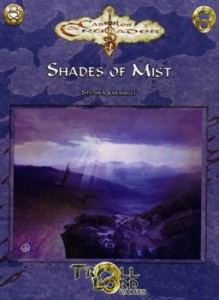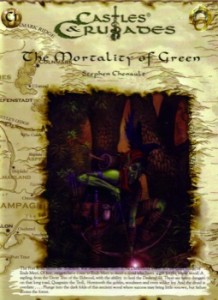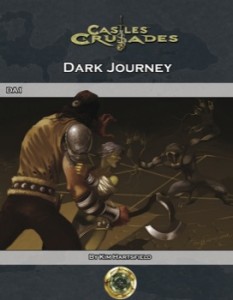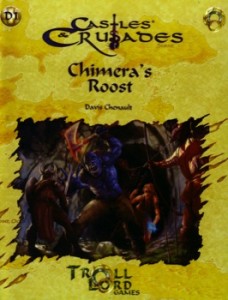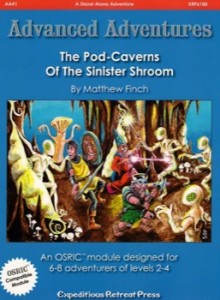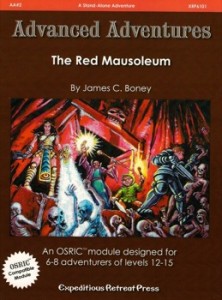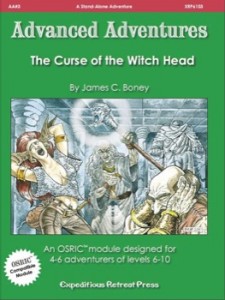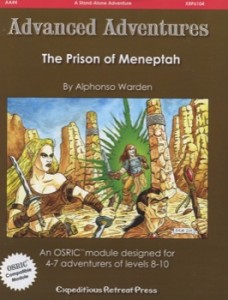This is an adventure module for Castles & Crusades, but can be used easily with any pre-4E version of D&D. More details on this aspect at the end.
This module expands on areas first mentioned in C1 – The Mortality of Green. In that adventure it was mentioned that the small village of Alice had been thrice cursed and met a terrible fate causing it to be abandoned. This is expanded upon in this module, which presents four separate interlinked areas to explore. There’s the town of Alice, two small cave complexes, and a ruined monastery that all have some relationship to each other. In addition, there is an overland adventure to actually reach the town of Alice.
The adventure starts in a tavern with the party overhearing a conversation at another table. What follows is nearly a page of boxed text, with a lot of “as you know”‘s and the like thrown in. It started in a nice way, with a guy reminding another of a load of goods they took to Alice and how he used to money to buy some nice thing. It then turns in to an oral history of ALice, where things go south a bit and turn in to a soliloquy. I _really_ don’t like that sort thing. Boxed text tends to be an abomination in my eyes, detracting from the adventure. In addition, the same information is repeated two or three times: once in the GM’s notes and once in the boxed text. It would have been nice if just a brief synopsis was provided to the DM and then the boxed text could be left out, with just a few suggestions on how to get the conversation started. Another person in the tavern overhears, and hires the party to go to Alice and retrieve his hidden wedding rings. He’s a survivor of what happened there and is growing a bit nostalgic in his old age.
With that the party sets off for Alice. There’s an overgrown road and also a river that could be taken. The regional map is on quite a large scale, 1″=32 miles. This throws me every time I see the map, although I suspect it’s just a mental block I have. The journey is going to take quite some time, over a week on feet over an overgrown road or several days by river. There’s a humanoid encounter on the way, as well as a pretty extensive, and generic, wandering monster table. The monsters in C1 had a very strong FEY feeling and atmosphere, but the wandering table in this module just feels like it was pulled out of some generic wandering monster table for a fantasy forest. I much preferred C1’s fey approach. The humanoid encounter has an extensive write-upabout 1.5 pages, and a lot of their tactics are presented, as well as their reactions and morale implications to what the party does. I’m torn over this. The write-up on their tactics & morale is good and well thought out, however the length of the description is a turn off. In addition, the humanoids seem rather generic. It’s not clear to me why they are not human bandits instead. Humanoids in c1 had a pretty strong fey atmosphere but that didn’t come through at all with this group. In addition, it’s suggested that the DM move the encounter from the river to the road if the party takes the longer road route. This is a big no-no in my book; you don’t move an encounter because the PC’s avoided it earlier. Let them make choices and let the dice fall where they will.
There are a couple of other encounters on the river which were very nice. Banshees travel in the mists that frequent the river and we get a nice little backstory as to why. It has a strong fey element and is very evocative. It’s also not necessarily a hostile encounter; the party can avoid fighting them and instead just get freaked out why the wailing faces that appear in the mist …. This is an excellent example of monsters having something to do besides eat PC’s. The banshees have their own agenda and are up to their own things; killing the PC’s doesn’t have to be a part of that. There’s also a nice encounter with a classic fantasy element. Again, it’s very well done and has a strong fey element to it. The strong fey feeling from C1/Mortality was one of my chief interests in it and I was happy to see portions of that show up again in module.
The regional scale map and the local maps didn’t make sense to me when compared to the text in the module. I couldn’t figure out very well how the areas related to each other, geographically, even though they are all on the maps and it’s written up in the text. The Text and the maps just don’t seem to sync up, or at least I couldn’t figure out how they did. This is really just a minor quibble, although it STILL has me bugged. The Lament of Alice has about eight keyed encounters in it. Only two involve monsters. One is a classic fey encounter, which should remind your players why everyone hate fairies. The other is a nice little encounter that is almost environmental in nature. It also ties back in to one of the three curses that fell on Alice. The tie in to the other three adventure areas is a loose one. There’s a path in the village, and if the party follows it for days then they’ll find another location. There’s also the well, alluded to in the tale in the tavern, which is another of the Alice curses. The party will have to follow the trail for days, blindly, or go in to the well.
The well location has a god in it. Yup, a full fledged god, although he’s down on his luck lately. The well leads to a nice little natural cavern complex with seven keyed locations. There have a variety of natural hazards associated with them, as well as the god and some vermin-type encounters. About half of the rooms have no creatures, as it should be. The old god should be a nice little role-playing encounter for the party, and can provide a nice swords & sorcery element and feel to the adventure. Frog Gods are cool. If the party pokes around they can find some nice treasure, and a passage that goes a mile till it comes up in an old Monastery; adventure location number 3.
The ruined monastery is mostly and exploration is crumbling rooms with about 20 keyed locations. There are some nice tricks and hidden locations and treasures located in the ruins. Again, there are only a couple of creature encounters. There’s a strong element of realism in the ruined sites presentation and encounters and some unguarded treasure can be obtained by a smart group. The site ALMOST introduces some elements of the weird, but never quite crosses over the line in to weird fantasy. It stays firmly in a ‘realistic depiction of a ruined monastery” mold, with a couple of fantasy elements thrown in. The site does show signs that it has been visited. Tracked back, the second small cavern complex, adventuring site four, is reached.
This is the small seven room cavern complex of a witch and her sons. They live in filth and have a couple of two-headed dogs (Nice) living with them. The complex has some natural elements, streams, and pools of water and such. They are holding someone hostage and are pretty much evil, through and through. This makes sense, since the witch is actually a hag! Module C1 did some things like this and I LOVED it, and I love it here also. Fantasy elements are presented as if they were just normal medieval elements, but then there is just a LITTLE more to them. The ugly barkeep woman is actually an ogre, or, in this case, the witch is actually a hag. It’s as if you’re in a VERY human-centric fairy tale and the line between fantasy and reality is just barely crossed. I thing that’s wonderful and gives lends to a strong fairy tale element to these two modules. It was much stronger in C1, but it is certainly present here also. Examples are the witch/hag and the ‘Old Gods’ such as the frog god the characters may meet, and the ruined monastery to the old gods. This is great and I wish were a lot more of it in this module. This second of caverns is more of a straight up fight, although there are a few weird elements and the hag is portrayed very realistically. IE: she doesn’t want to die, sacrifices her idiot sons to make sure she doesn’t and uses her powers to good effect.
When I run this I’ll have to make sure that the adventuring locales are tied together a little more. I may drop hints of the backstory as well, but not reveal it all; mystery and the unknown are powerful tools to evoke a sense of wonder. I wish the module had played up the few elements a little more, and I also wish the wandering table was a little more fey oriented and specific. While these are not dungeoncrawls, in my definition, the sandboxy like story they present is a very nice one.
I just use the C&C stats for the monsters in my D&D game, converting the AC on the fly since C&C AC ascends. You could also just the monster straight out of the D&D monster manual. There are a few places that call for skill checks. In a 3E game you just add the C&C Challenge Level to 15 to get the DC. In more old school D&D games you can just make a tracking check, bend bars check, or attribute check. I calculate monster XP from the DMG 1E tables.
This is available at DriveThru.
https://www.drivethrurpg.com/product/58560/Castles–Crusades-C2-Shades-of-Mist?affiliate_id=1892600

